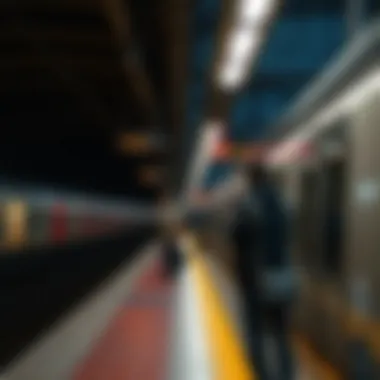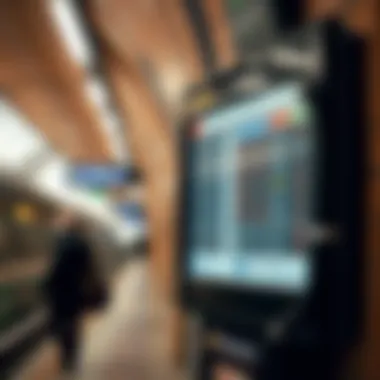Understanding Metro Station Closing Times for Commuters


Intro
Navigating the urban landscape requires an understanding of its rhythm, particularly when it comes to metro stations. Knowing when these hubs of transit close can significantly shape our daily commutes. Whether you're a commuter, a traveler, or a city dweller, the closing times of metro stations are pivotal. They impact not just personal schedules but also the broader framework of urban mobility and planning.
Key aspects about metro station closing times that will be explored include operational schedules, how regional differences come into play, and the ever-evolving needs of travelers. This narrative aims to go beyond simple timetables, diving deeply into how these closing hours can either facilitate or obstruct efficient travel. Furthermore, we'll touch upon future developments that could reshape the very fabric of metro services as urban areas strive to meet the evolving demands of an increasingly mobile population.
As we unpack these layers, it’ll become clear that understanding metro station closing times isn't merely a matter of knowing when to catch the last train; it’s about leveraging this knowledge for a smoother, more informed commuting experience.
Overview of Metro Systems
Metro systems play an essential role in urban transport, serving as the backbone of public transportation in many cities. Not only do they facilitate the movement of thousands of passengers daily, but they also help reduce traffic congestion and lower greenhouse gas emissions. Understanding the significant aspects of metro systems is crucial, especially for those who rely on these services for their daily commutes, as well as for city planners and investors looking to optimize urban movement.
The Role of Metro Systems in Urban Transport
The role of metro systems in urban transport cannot be overstated. They provide an efficient, fast, and reliable means of transportation that meets the needs of busy city dwellers. By whisking people from one place to another quickly, metros alleviate the burden on surface streets, allowing for smoother traffic flows and shorter travel times. Moreover, metros are often regarded as an environmentally friendly option when compared to personal vehicles, ensuring cleaner air in bustling metropolitan areas.
In cities like Paris, Tokyo, and New York, the metro is integrated seamlessly into the urban fabric. Passengers can navigate large populations without undue delays, thanks to well-planned routes and frequent services. Moreover, the socio-economic dimensions of metro systems extend beyond immediate transit solutions. For instance, they can spur economic growth in previously underserved neighborhoods by improving accessibility to jobs and resources.
Different Models of Metro Operations
Metro systems vary significantly in how they operate. Here, we can generally observe three main models of operation: self-financing, subsidized, and structured as a public-private partnership.
- Self-financing: Some metro systems, like the MTA in New York, operate largely through fare revenue, focusing on maintaining a self-sustaining model. They typically seek to minimize public funding by maximizing ridership and operational efficiency.
- Subsidized: Other systems, especially in smaller cities or developing regions, may rely heavily on government subsidies. This encourages accessibility but can strain public budgets if not managed effectively.
- Public-Private Partnership: In some instances, private companies work alongside governments to develop and operate metro services. This model can lead to increased investment and innovation but often raises questions about accountability and service quality.
Each model has its advantages and challenges. For investors, understanding these frameworks is crucial, as they have deep implications for how metro systems evolve and their closing times will be influenced by operational costs, ridership demographics, and regulatory hurdles.
Investing in a city’s metro infrastructure is essentially investing in its future. It shapes urban life, impacting everything from property values to daily commuting experiences.
By grasping the fundamentals of metro systems, stakeholders can better appreciate how closing times are determined and adjusted in response to myriad factors – thus enhancing overall urban mobility.
Factors Influencing Closing Times
Understanding the factors that inform metro station closing times is crucial for effective urban planning and commuter reliability. These times are shaped by a complex interplay of demand, operational needs, and regional differences. Highlighting these aspects allows us to see how shifts in one area might impact overall transportation accessibility and commuter experiences.
Passenger Demand Patterns
One of the predominant factors affecting metro station closing times is the patterns of passenger demand. Commuters often exhibit fluctuating travel behaviors throughout the day. For instance, during rush hours, the metro sees a surge in users, leading to a higher demand for extended service hours. Conversely, late-night travel typically sees a drop in ridership, which can influence how late services run.
- Peak Hours: The demand spikes during morning and evening, usually when people commute to and from work or school.
- Weekends vs. Weekdays: Many urban areas experience different demand patterns based on the day of the week. For example, on weekends, a night out might keep the stations busier past the usual closing hours, prompting a need for later operations.
- Event-Specific Needs: Large events—be it concerts or sports matches—can lead to a last-minute influx of passengers, proving that metro systems must remain adaptable to changing demand patterns.
Operational Considerations for Metro Services
When deliberating on closing times, metro agencies must heed various operational considerations. The interrelation between safety, efficiency, and service quality plays a critical role in decision-making. We can further break this down:
- Maintenance Schedules: After hours, train cars and tracks often require maintenance. Closing times must account for these needs to ensure trains are safe and well-maintained for daily commutes.
- Staffing Levels: Operating a metro system involves considerable manpower, which can become limited during late-night hours. Ensuring enough staff is on hand for both passengers and operational responsibilities is crucial. Staffing must also meet safety and security requirements, as late-night travel can raise different safety concerns.
- Route Efficiency: The operational protocols are designed to create seamless transitions between routes. Closing times are often set to maximize the efficiency of the service while also considering essential factors like energy savings and cost control.
Regional Variations in Closing Hours
The geographical location of a metro system plays a significant role in determining its closing hours. While some cities might boast a robust nightlife that necessitates longer operating hours, others may not have the same demand.
- Cultural Factors: Generally, areas known for entertainment and nightlife, like New York City, often have metro systems that operate until 2 AM, catering to various cocktail enthusiasts. In contrast, smaller cities or those with less nightlife might close their systems much earlier, reflecting local habits and preferences.
- Legislation and Funding: Regulations imposed by local governments can influence service hours. Many transit systems undergo annual budgeting discussions which can determine whether extended hours are feasible.
- Community Input: Metro services often conduct surveys to assess community needs, directly linking regional variations to the input from commuters. Feedback loops can indeed lead to changes in closing hours based on what users feel is important.
In summary, the interplay of passenger demand patterns, operational considerations, and regional variations all significantly influence metro station closing times. Understanding these factors not only enhances commuter experience but also helps metro authorities adapt to the ever-evolving landscape of urban transportation.
Typical Metro Station Closing Times
Understanding metro station closing times is crucial for both daily commuters and urban planners. These times dictate the rhythm of city life, influencing how people interact with public transport systems. A well-timed metro service can ease the stress of travel, while closing times that don’t align with commuter needs can lead to confusion and inconvenience.
Standard Closing Times Across Major Cities
Closing times for metro stations vary significantly from city to city, reflecting each area's unique transportation demands and urban planning considerations. For example, in New York City, the subway generally operates until 1 a.m., but on weekends, this can extend past 2 a.m., catering to the nightlife culture that thrives in the city. In contrast, Tokyo often sees its stations close by midnight during weekdays, reflecting a different pace of life.
Cities that host major international events or have vibrant tourist attractions tend to have longer operating hours. London's Tube, for instance, has been known to stretch its hours on special event days or holidays, demonstrating a responsiveness to commuter needs. This flexibility can significantly enhance the overall travel experience.


"In cities where the night-life is robust, metro systems flex their hours, offering a lifeline to those who enjoy late-night outings."
Peak vs Off-Peak Closing Strategies
Strategically managing closing times is as much about ensuring safety as it is about serving passenger demand. During peak hours, when ridership is at its highest, some metro systems may opt to extend service times slightly. They recognize that commuters returning home from late work shifts need that flexibility. For instance, Paris has traditionally altered its closing hours based on demand, allowing for extended service during major cultural events.
In contrast, during off-peak hours, metro services might follow a more condensed schedule, resulting in earlier closing times to allow for maintenance and reduce operational costs. This can particularly be observed in systems like Berlin's U-Bahn, where the late-night service is significantly reduced on weekdays compared to weekends. The ability to dedicate time for cleaning and regular upkeep is vital in maintaining efficiency and safety for riders.
By prioritizing peak hours, cities can maximize their operational efficiency and cater effectively to the commuting populace. This dynamic approach not only supports passenger convenience but aligns with overall urban transport strategy.
Impacts of Closing Times on Commuters
Understanding the impacts of metro station closing times on commuters is crucial for grasping how urban mobility functions on a day-to-day basis. The timing of these closures does not merely dictate when trains stop running; it weaves into the very fabric of daily life for millions of people. Commuters depend on predictable schedules for their travel plans, job commitments, and social activities. So, when these schedules shift or vary, the consequences can ripple through their routines—sometimes in significant ways.
Travel Planning and Adaptability
When it comes to urban commuting, the old saying holds true: "Failing to plan is planning to fail." For many, the opening and closing hours of metro stations serve as the foundation upon which daily itineraries are built. If someone knows that the last train departs at midnight, they can manage their time accordingly, whether they're heading home after a late shift or enjoying a night out with friends. However, deviations in these hours can disarray even the best-laid plans.
The importance of adaptability becomes stark in cities with dynamic nightlife or significant late-night events. Take the example of New York City, where weekend subway service can run on reduced schedules, affecting travel times unexpectedly. A visitor unfamiliar with the system might find themselves stranded at a station, scrambling for alternative transport options.
To efficiently adapt to changing closing times, commuters can:
- Utilize mobile apps: Many metro systems offer real-time updates on train schedules and possible changes. Being plugged into these apps gives commuters the upper hand.
- Join community forums: Platforms like Reddit can serve as valuable resources where locals discuss schedules, late-night closures, and alternatives.
- Engage with metro services: Feedback mechanisms are often in place. Commuters can voice their concerns or suggestions about service hours through local transport authority websites or social media channels.
Safety Considerations for Late-Night Travel
For many travelers, the idea of navigating metro systems during late hours stirs both curiosity and caution. Safety emerges as a paramount concern as darkness envelops city streets. Statistics show that incidents can rise in low-traffic environments, so knowing when the last train leaves is essential. Safety concerns drive many to ponder how they might fare on the platform or inside a car late at night.
Consider the absence of other commuters in the case of a late-night ride. A person might feel uncomfortable when they find themselves alone in a station, especially if they’re heading to unfamiliar neighborhoods. Here, a sound understanding of metro closing times can directly influence safety and peace of mind.
To enhance safety during late-night travel, passengers should:
- Travel with a buddy: There’s strength in numbers. Finding a commuter buddy can improve safety and comfort on late-night rides.
- Be observant: Familiarize yourself with the station layout and emergency procedures. This way, one can quickly react if anything feels amiss.
- Consider alternatives: If the closing times of metro stations leave no room for safe travel, options like rideshare services (Uber, Lyft) or even local taxis become invaluable.
"Knowing your way around metro closing times is not just an inconvenience; it’s essentially a matter of personal safety and effective planning."
In examining the impacts of metro closing times on commuters, we uncover how intertwined our routines and safety perceptions are with this urban infrastructure. Awareness and adaptability can make all the difference, transforming potential frustration into a smooth experience. As cities evolve, so too must our understanding of these essential transport networks.
Future Trends in Metro Operations
The landscape of urban transportation is evolving at an impressive pace, with metro operations at the forefront of these changes. This section examines how technological advancements and shifting urban environments are reshaping the way metro services function, influencing both closing times and commuter experience. Understanding these trends is crucial for all stakeholders, including investors, realtors, homeowners, expatriates, and renters who want to navigate urban mobility effectively.
Technological Innovations Affecting Closing Hours
Recent advancements in technology are fundamentally reshaping the operations of metro systems. Notably, the introduction of real-time data analytics platforms allows for more responsive closing times. With tools that analyze passenger flow, operators can adjust service hours to meet actual demand rather than sticking to inflexible timetables. This shift not only optimizes resource allocation but also improves commuter satisfaction. For instance, cities like Singapore have implemented smart sensors that monitor crowd levels, enabling them to extend service during peak periods and minimize waiting times.
Additionally, mobile applications equipped with artificial intelligence provide commuters with up-to-the-minute information regarding service adjustments. These applications can predict delays and notify users, allowing them to plan their journeys more effectively. It's a win-win for metro systems: they reduce congestion, enhance user experience, and operate more efficiently.
Evolving Urban Landscapes and Their Influence
Urbanization is changing cities at breakneck speed. As populations in urban areas swell, the demands on metro services intensify. With developments like mixed-use complexes and transportation hubs popping up, metro systems must be agile enough to adapt to these changes. Service hours are likely to stretch to accommodate shifting work patterns and nightlife activities, particularly as more people choose to live and work in the same vicinity.
Moreover, cities are increasingly prioritizing pedestrian-friendly initiatives, which mean enhanced accessibility to metro stations. These changes necessitate longer operating hours to ensure all city dwellers can utilize public transit effectively. For example, metro systems in cities such as New York and Los Angeles are considering pilot programs for 24-hour service, acknowledging the need to accommodate increasingly diverse commuter schedules.
"Infrastructural changes necessitate a review of closing hours. The success of metro services can hinge on their flexibility to accommodate new urban trends."
These trends indicate that the future of metro operations will be defined by a balance between technological integration and an understanding of urban dynamics. As these systems evolve, the implications for closing times will be profound, ensuring that urban transit can meet the ever-changing needs of its users.
Case Studies of Notable Metro Systems
Analyzing metro systems around the world provides invaluable insights into how different regions have developed their transport networks and crafted closing strategies that address local needs and conditions. The importance of such case studies lies in their ability to showcase a variety of methods and approaches taken in organizing metro schedules. This section aims at providing a deeper understanding of how closing hours are implemented and how they can significantly shape the commuting experience.
Analysis of Closing Timings in Global Metro Networks


Various metro systems differ not only in the geographical aspects but also in operational practices and closing hours. For instance, cities like Tokyo, which is known for its punctuality and efficiency, typically have closing times around midnight on weekdays. However, during weekends, service might extend until around 1 AM to accommodate the nightlife. Other cities, such as London, implement different strategies; their Underground often operates later on Fridays and Saturdays, catering to a vibrant night culture.
Key Points on Closing Timings:
- Tokyo Metro: Close around midnight on weekdays and 1 AM on weekends
- London Underground: Extended hours on weekends to embrace nightlife
- New York City Subway: Generally closes between 1 AM and 5 AM for maintenance, demonstrating a balance between operational needs and commuter service
The variance in closing timings reflects adaptation to urban life and demands across global metro networks.
Lessons Learned from International Practices
Studying these diverse operational hours reveals certain lessons that can be applicable universally. One vital takeaway is understanding the balance between demand and operational efficiency. Some systems, like those in Berlin, utilize data analytics to forecast passenger flow, allowing them to tweak service times efficiently. They are responsive to commuter patterns, which means management can take informed decisions based on real-time feedback.
Moreover, engaging with the community to grasp their needs emerges as a recurrent theme. For example, the Los Angeles Metro conducted community surveys to gather opinions on service schedules, which ultimately drove changes towards more accommodating hours for late-night workers and events.
Valuable Lessons:
- Data-Driven Decisions: Using analytics for operational adjustments
- Community Engagement: Involving residents in discussions to enhance service
- Flexibility: Adapting service schedules based on actual ridership data
As closing times continue to evolve, learning from these case studies not only highlights successful practices but also fosters a framework for future planning and operational excellence within other metro systems.
Adapting to Changing Commuter Needs
Understanding and responding to changing commuter needs is crucial for metro systems aiming to serve their populations effectively. With urban landscapes evolving and lifestyles shifting, metro services must adapt to ensure they continue to meet the demands of riders. This section dives into how feedback mechanisms and community engagement strategies play a significant role in this adaptation process.
Feedback Mechanisms for Improving Service Hours
Feedback mechanisms are vital for gauging commuter satisfaction and identifying areas for improvement in metro operations. Metro authorities often utilize surveys, suggestion boxes, and social media platforms to collect valuable insights from passengers. For example, the Washington Metropolitan Area Transit Authority (WMATA) has an online tool where riders can submit feedback directly about their experiences. This approach facilitates a two-way communication channel, ensuring that rail authorities not only disseminate information about service changes but also listen to commuter concerns and suggestions.
The cycle of feedback significantly influences service hours and policies. As ridership trends shift—such as the increased demand for late-night service in cosmopolitan areas—metro systems can adjust their hours accordingly. Additionally, real-time data analytics, gleaned from ticket sales and usage patterns, can illuminate peak travel times, leading to more informed scheduling decisions. The integration of mobile apps that allow users to report issues or suggest improvements can also enhance responsiveness. By nurturing this feedback culture, metro systems can better align their service hours with the actual needs of users.
Community Surveys and Engagement Strategies
Community surveys represent another form of interaction, providing a broader understanding of commuter preferences and behavior. Surveys can encapsulate various aspects—like preferred closing times, willingness to pay more for extended hours, or the perceived safety of traveling late at night. With the right questions, these surveys can reveal deep insights that inform operational changes.
Engagement strategies can extend beyond surveys; hosting community forums can foster collaboration between local authorities and commuters. For instance, the San Francisco Bay Area Rapid Transit (BART) might host public meetings where riders are encouraged to voice their thoughts on proposed changes. Such dialogues not only build trust between users and transit agencies but also create a sense of community ownership over the metro service.
Moreover, leveraging digital platforms for engagement is becoming increasingly popular. Social media campaigns or dedicated apps can keep commuters informed and involved in the decision-making process. This approach allows metro authorities to reach diverse demographic groups, ensuring that feedback is inclusive and representative.
"Engagement is not just about altering service hours; it’s about building a partnership with the community to mirror their evolving lifestyles and needs."
By prioritizing responsiveness and enhancing engagement, metro systems can navigate the complexities of urban commuting more successfully, paving the way for future innovations.
Navigating Late-Night Travel
Traveling late at night can be a tricky affair, especially when metro systems have limited service hours. This section digs into how to maneuver through after-hours commutes, highlighting crucial alternatives and considerations for a secure journey home.
Alternative Transport Options for After-Hours
When city life doesn’t sleep, neither should the options for getting around. Though metro stations may shut their doors, commuters can explore various transport alternatives designed for late-night travel. These choices often supplement metro services to ensure that residents and visitors don’t find themselves stranded.
- Ride-Sharing Services: Platforms like Uber and Lyft have become popular go-tos for late-night travel. Riders can summon a ride with just a few taps, which can be reassuring after a long evening out. The convenience factor can be a game-changer when traditional public transport isn't operational.
- Taxis: The classic yellow cab still runs strong in many urban settings. They are generally available 24/7, providing a reliable alternative when subways are offline.
- Night Buses: Many cities implement specific night bus routes aimed at transporting late-night revelers. While less common than regular services, these can offer a wallet-friendly option for those who prefer public transportation over taxis or rideshares.
- Bicycle Rentals: Some urban areas offer bike-sharing programs that operate late into the night. For those comfortable on two wheels, this can be a fantastic way to navigate the streets, particularly on beautiful evenings.
Commuters should plan ahead to determine what alternatives are available, ensuring a smooth end to their night.
Planning Safe End-of-Night Journeys
When stepping out late, safety is paramount. Proper planning can make a significant difference in ensuring a secure end to one’s journey. Here are practical tips to consider:
- Know Your Route: Familiarize yourself with the route options before stepping out. Maps and transport apps are widely available and can provide real-time updates about your journey.
- Don’t Go It Alone: Where possible, travel with a buddy. There’s safety in numbers, and having someone to share the journey can ease the concerns associated with late-night travel.
- Stay Aware: It’s important to stay vigilant about your surroundings. Put the phone away and keep your head up while walking, which is crucial for personal safety, especially in dimly lit areas.
- Trust Your Instincts: If you ever feel uneasy about a situation or location during your journey, don’t hesitate to change your course or seek help from a nearby establishment.
"Always stay alert and don’t let your guard down, even at night. A few simple precautions can go a long way in ensuring your safety."
In summary, navigating late-night travel doesn’t have to feel like a precarious endeavor. By being informed, utilizing available transport options, and planning ahead, commuters can confidently find their way home, regardless of the hour.


Legislative Considerations
In the realm of urban transit systems, the topic of legislative considerations emerges as a key player in shaping and governing metro operation hours. It’s not just about getting from point A to B; the rules and regulations that dictate how and when services run have vast implications for daily commuters, safety, and city planning. This section will unfold the various layers of legislation that form the backbone of metro services, addressing the direct impact on closing times and, subsequently, the rider experience.
Regulatory Framework Governing Metro Operations
A well-defined regulatory framework is vital to the efficient running of metro operations. This framework typically includes federal, state, and local legislation, each bringing its unique flavor and stipulation. For instance, laws governing transportation safety can mandate that systems provide adequate lighting and surveillance in stations, particularly during late-night hours. Without these rules in place, scenarios that jeopardize commuter safety could arise, leading to a decrease in public trust.
Moreover, the Federal Transit Administration (FTA) offers guidelines that can affect how metro systems manage and schedule their services. These guidelines can encompass funding allocations, compliance checks, and operational standards. The regulations serve not just as a rulebook, but also as a guide toward proactive safety measures and service reliability, influencing the closing times of metro stations to foster a secure environment.
It's essential for stakeholders—ranging from local government officials to service managers—to be well-versed in these regulations.
"A thorough understanding of the laws ensures that the services align with both riders' expectations and safety standards."
Impact of Local Governance on Service Hours
Local governance plays a crucial role in not only shaping the operational hours of metro services but also in how adaptable those hours can be to meet community needs. Different locales often have distinct ridership demands that can fluctuate based on time and day. As a result, local transit authorities may lobby for legislation that supports extended service hours during specific periods, particularly during weekends or special events.
Consider the case of a city that hosts an annual cultural festival. Local government bodies may push for longer operating hours during this period to accommodate increased passenger demand. Such adaptations often involve negotiations with various stakeholders, including unions, who look out for worker safety and job security. The balance between community needs and operational viability is delicate, necessitating an intricate interplay among local laws, regulations, and the practicalities of metro service management.
The dialogue between metro systems and local governance ultimately exemplifies a microcosm of civic engagement—citizens advocating for their transportation needs while authorities respond to those needs pragmatically, thereby affecting how late-night travel is managed and perceived.
In summary, legislative considerations are not merely bureaucratic hurdles; they serve as foundational structures that shape urban mobility. They ensure that metro operations remain aligned with public safety expectations, financial accountability, and community demands.
Understanding these dynamics equips investors, realtors, homeowners, expatriates, and renters alike with the knowledge they need to navigate a complex landscape that dictates how and when they can rely on this vital form of transportation.
User Experience and Perception
User experience and perception play pivotal roles in shaping the daily interactions commuters have with metro systems. The convenience and efficiency of public transport are often gauged through the lens of how users perceive closing times and the overall safety of traveling during late hours. When user experience is positive, it's not just commuters who benefit; it enhances the overall attractiveness of metro systems and urban transport as a whole.
Well-designed metro operations can significantly elevate commuter satisfaction. This encompasses more than just punctual trains; it involves crafting an experience that considers the safety and comfort of passengers. A metro's closing time isn't merely an operational detail; it's a reflection of the city's commitment to its residents and visitors. Properly aligning service hours with actual passenger needs is essential in ensuring that users feel valued and prioritized.
Commuter Feedback on Closing Times
Hearing from commuters about their satisfaction regarding metro closing times helps metro authorities make informed decisions. Real stories about late-night rides or the frustration of missing the last train hold a wealth of information. Many commuters express a desire for extended service hours, especially in bustling urban areas where nightlife thrives. This feedback serves as a critical lifeline to transport operators who aim to align services with real-world demands.
The process of gathering feedback can take various forms, ranging from surveys to community meetings. Agencies often use tools like social media or dedicated platforms to gauge public sentiment efficiently. For instance, cities that have enacted extended hours have witnessed a rise in user engagement, indicating successful adaptation to what people need. Commuter insights contribute not only to operational improvements but also to fostering a sense of community ownership over public transport.
"We don’t just want more trains; we want them when we really need them!" - A common sentiment among late-night commuters.
Perception of Safety During Late Travel
Feeling safe while traveling late at night is crucial, and this perception heavily influences commuting decisions. Commuters often weigh their options based on how safe they perceive the metro system to be after normal closing hours. Many reports indicate that better lighting, more visible staff, and robust surveillance make travelers feel more secure. The less safe riders feel, the fewer they will be willing to travel during late hours, which can lead to under-utilization of services.
Moreover, the perception of safety extends beyond just the train cars and platforms. It encompasses the entire journey, from the moment one sets foot at the station to the time they arrive at their destination. Cities that have made crucial investments in security features tend to see a positive shift in community trust regarding their metro systems. This kind of trust can lead to increased late-night ridership that not only benefits the service provider but positively impacts the economy of the area as well.
Communities today often demand transparency about safety measures in place during late travel. When metro authorities make it a point to openly communicate these safety policies, it greatly enhances commuter confidence. Keeping users informed goes a long way in reassuring them that their safety is a top priority, fostering greater use of the metro even during off-peak hours.
Culmination
The conclusion of this article serves as a crucial capstone to the extensive discussion surrounding metro station closing times. Comprehending the nuances of these timings has profound implications not only for commuters but also extends its significance to urban planners, local businesses, and investors alike. It’s not merely about the hour at which trains stop running; it encapsulates a larger narrative about urban mobility, accessibility, and economic vitality.
Summarizing Key Findings
Throughout our exploration, several pivotal points emerged:
- Operational Schedules: Metro systems must strike a balance between providing service and managing operational costs. Adapting to real-time passenger demand is crucial.
- Regional Variations: Closing times differ widely across metropolitan areas. For instance, cities like New York maintain extended hours, while others, such as San Francisco, might not operate late into the night.
- Commuter Impact: Understanding individual commuter patterns can guide metro authorities in optimizing their service hours. Feedback collection has shown that commuters desired longer hours for leisure activities and late jobs.
In a nutshell, these findings underline the importance of adapting to evolving urban landscapes and commuter expectations. Cities that leverage these insights can improve public transport systems, thereby enhancing commuter satisfaction and safety.
Future Directions for Research
Looking ahead, several areas warrant further investigation:
- Technological Integrations: There’s significant promise in exploring how automation and smart technologies can reshape metro operations, potentially leading to safer, faster, and more reliable service.
- Impact of Urban Growth: With cities expanding rapidly, understanding how population changes influence travel patterns and service demand at different times is critical.
- Sustainability Factors: Research could focus on how eco-friendly policies surrounding closing hours can benefit both the environment and urban traffic systems.
Engaging in comprehensive research on these fronts will assist in developing forward-thinking strategies that accommodate tomorrow’s urban challenges. By addressing the complexities of metro station closing times through informed studies, we can forge a public transportation landscape that’s not only efficient but also responsive to the needs of a diverse population.
"Investing in research on metro operations is not just an obligation; it's a gateway to enhancing urban lifestyle and ensuring public safety."
As we conclude this insightful journey, it’s clear that the awareness surrounding metro station closing times plays a foundational role in shaping our daily lives and overall urban experience.



